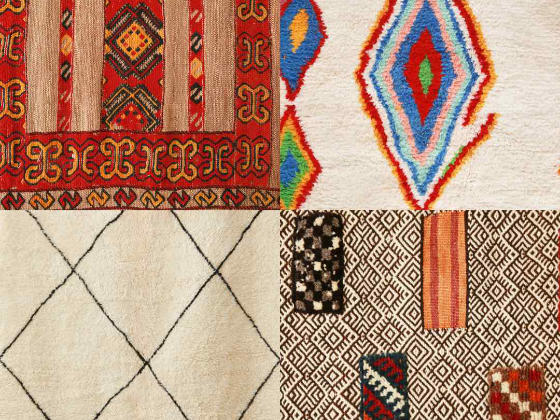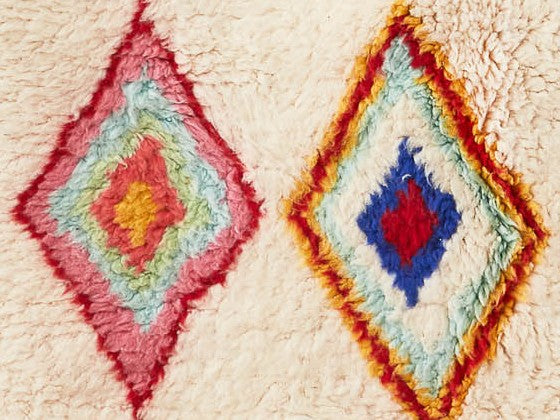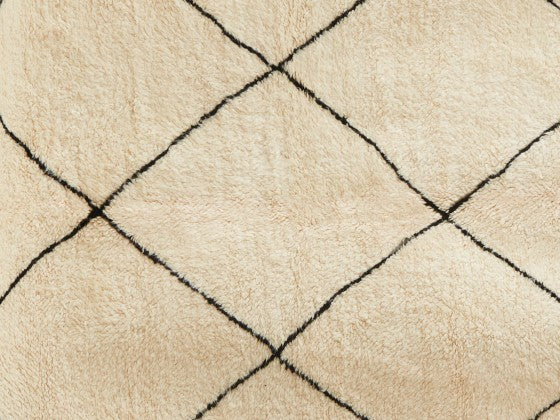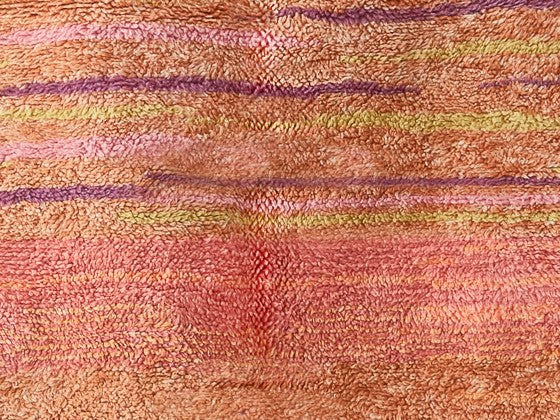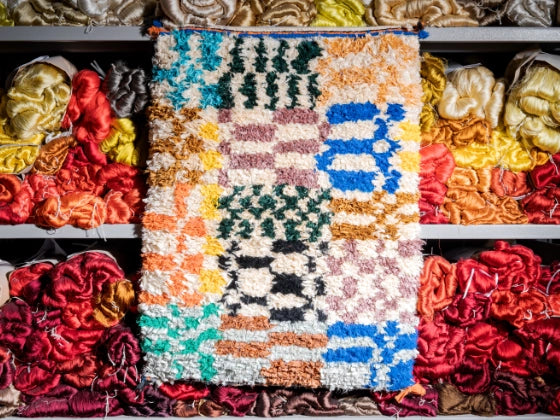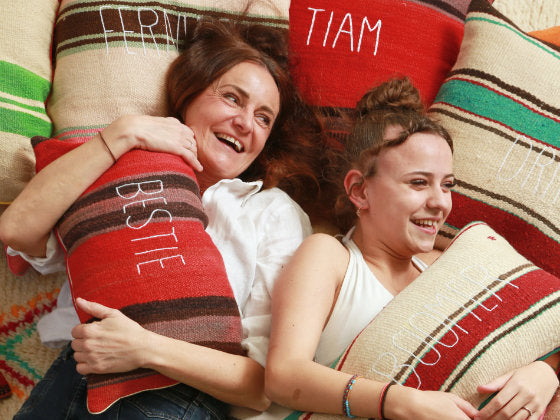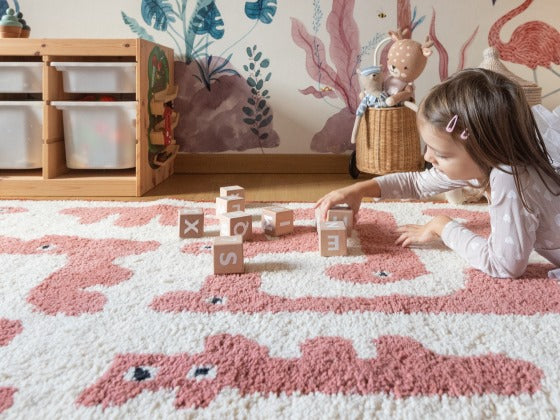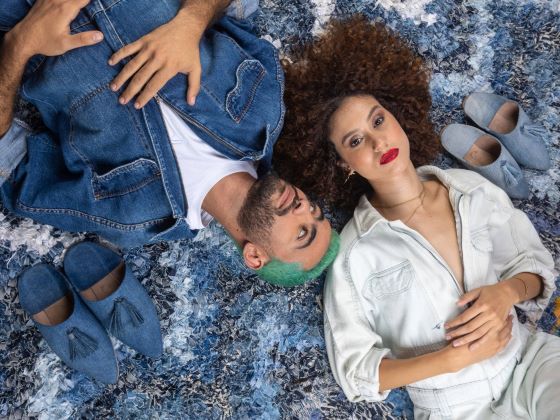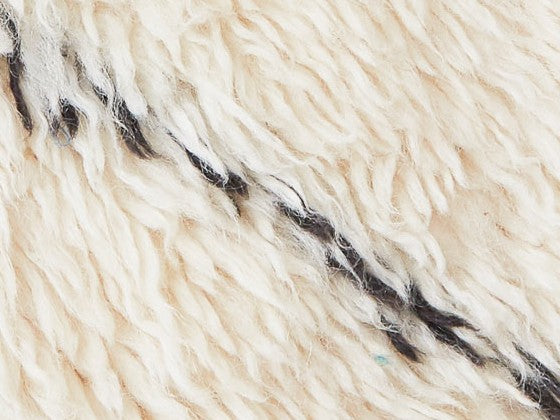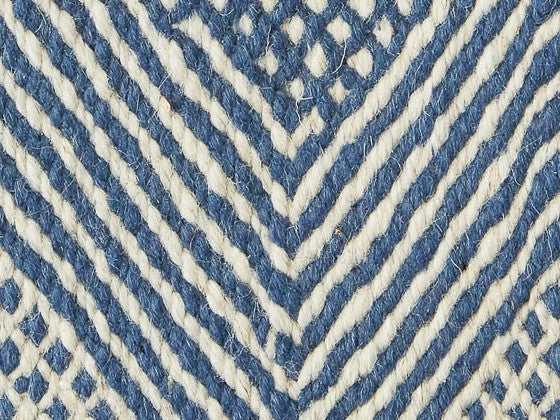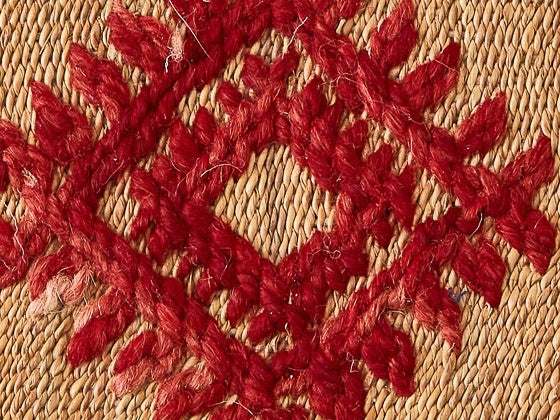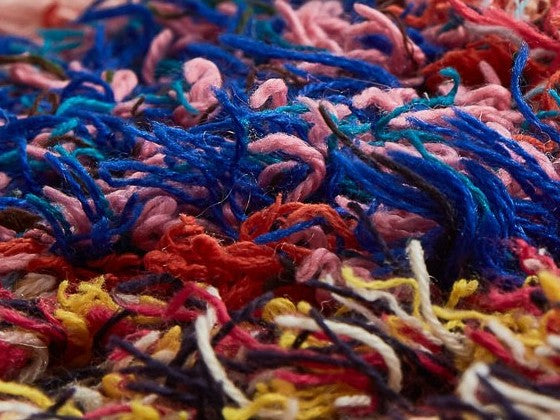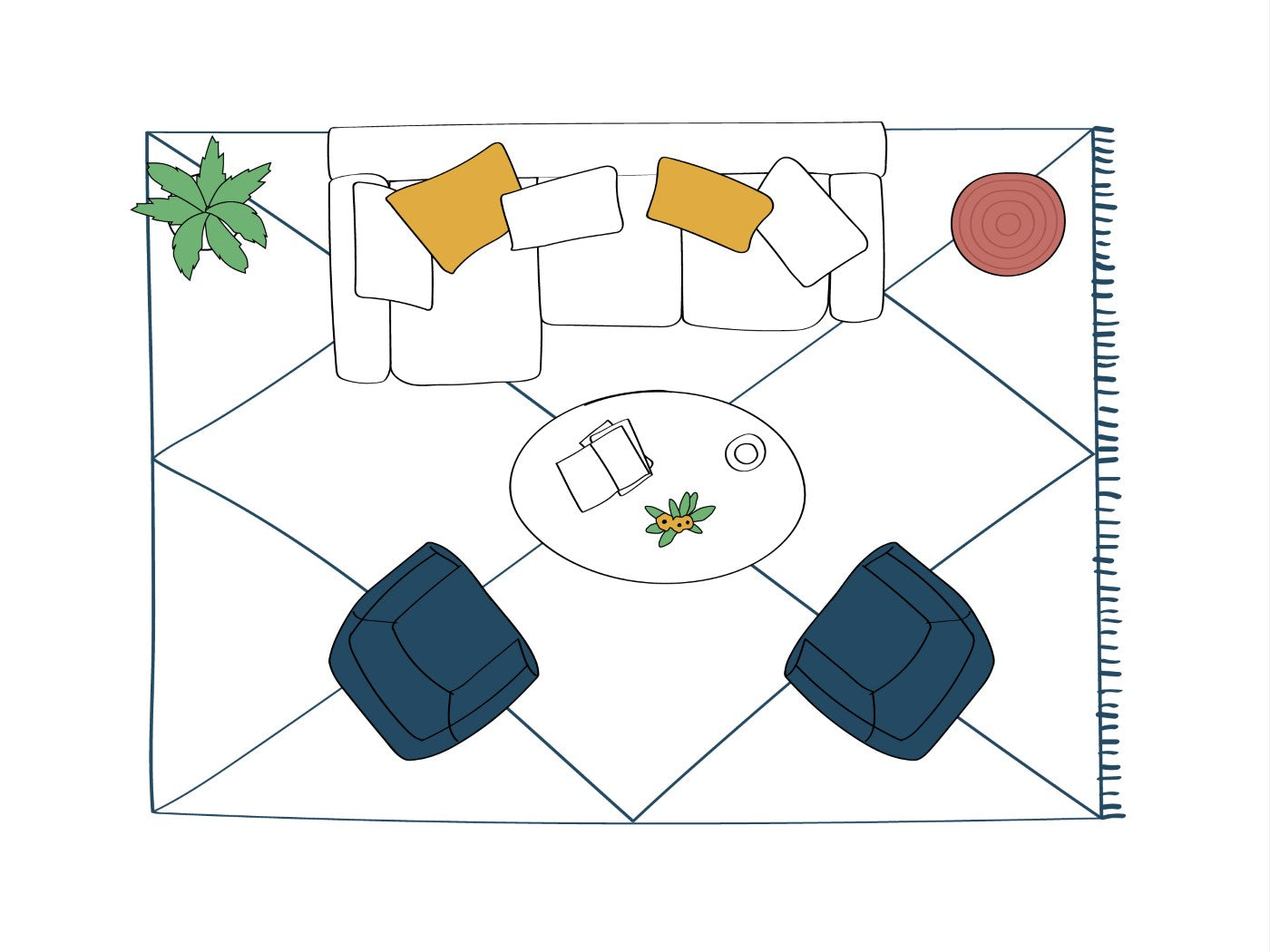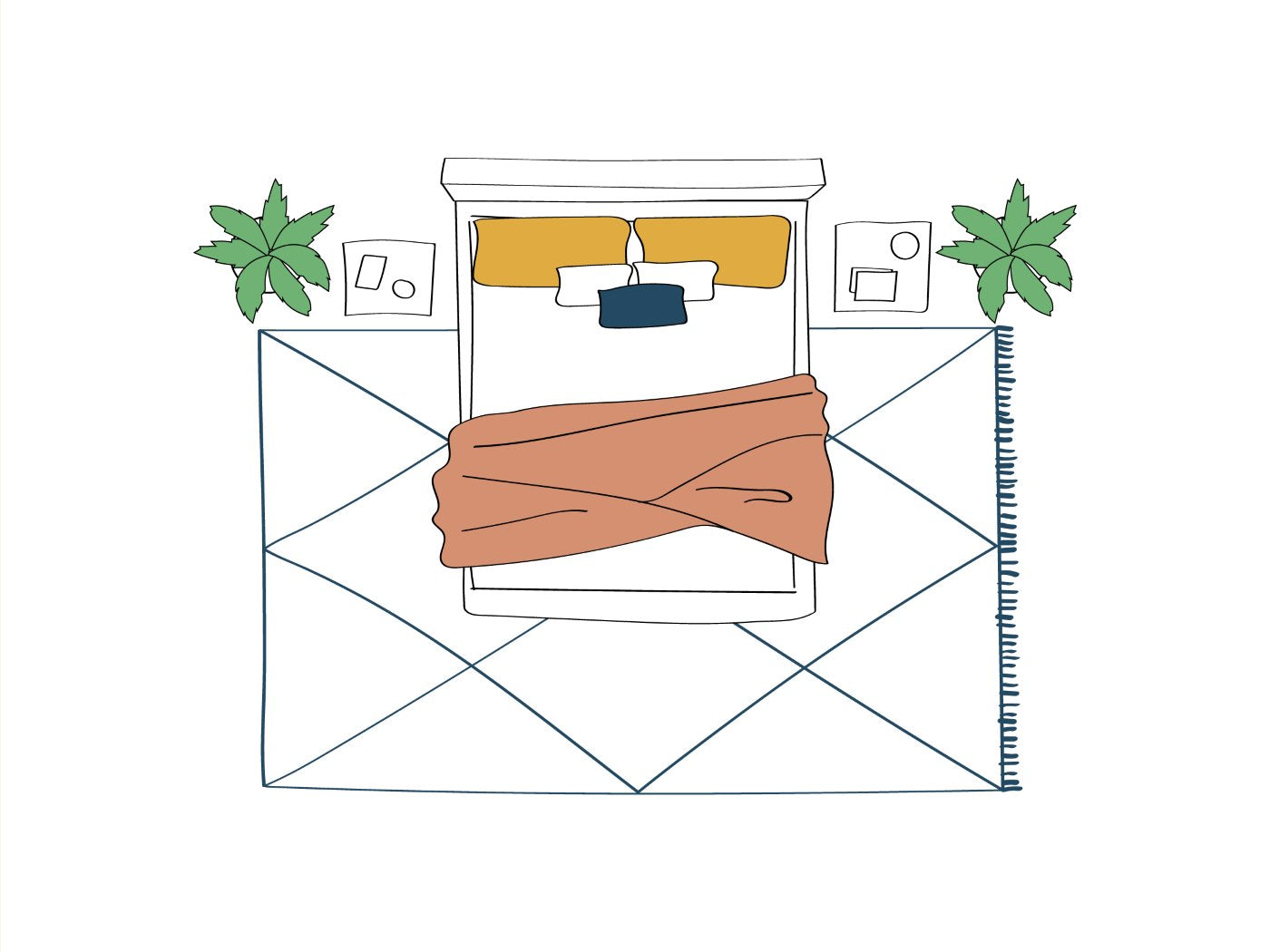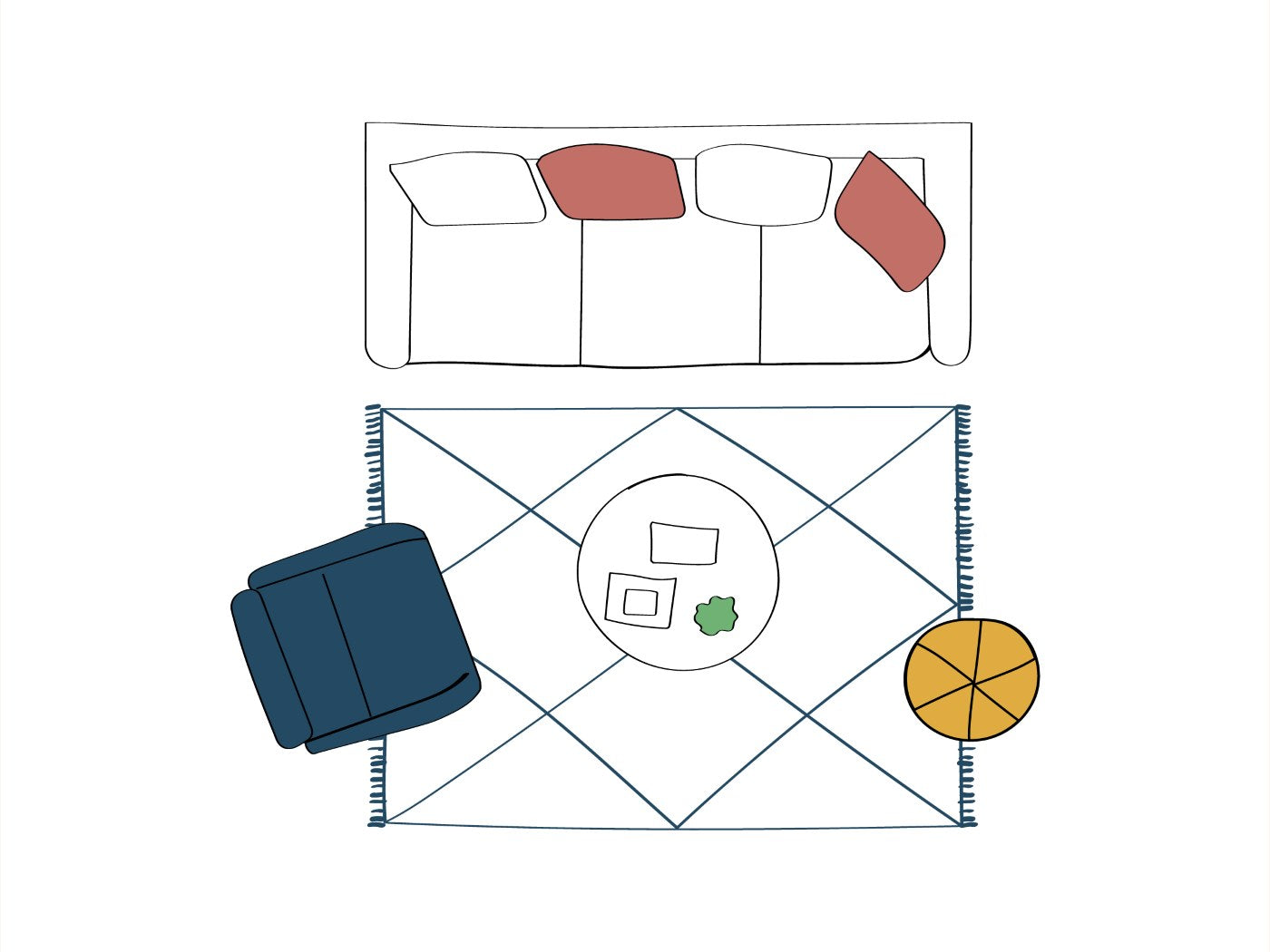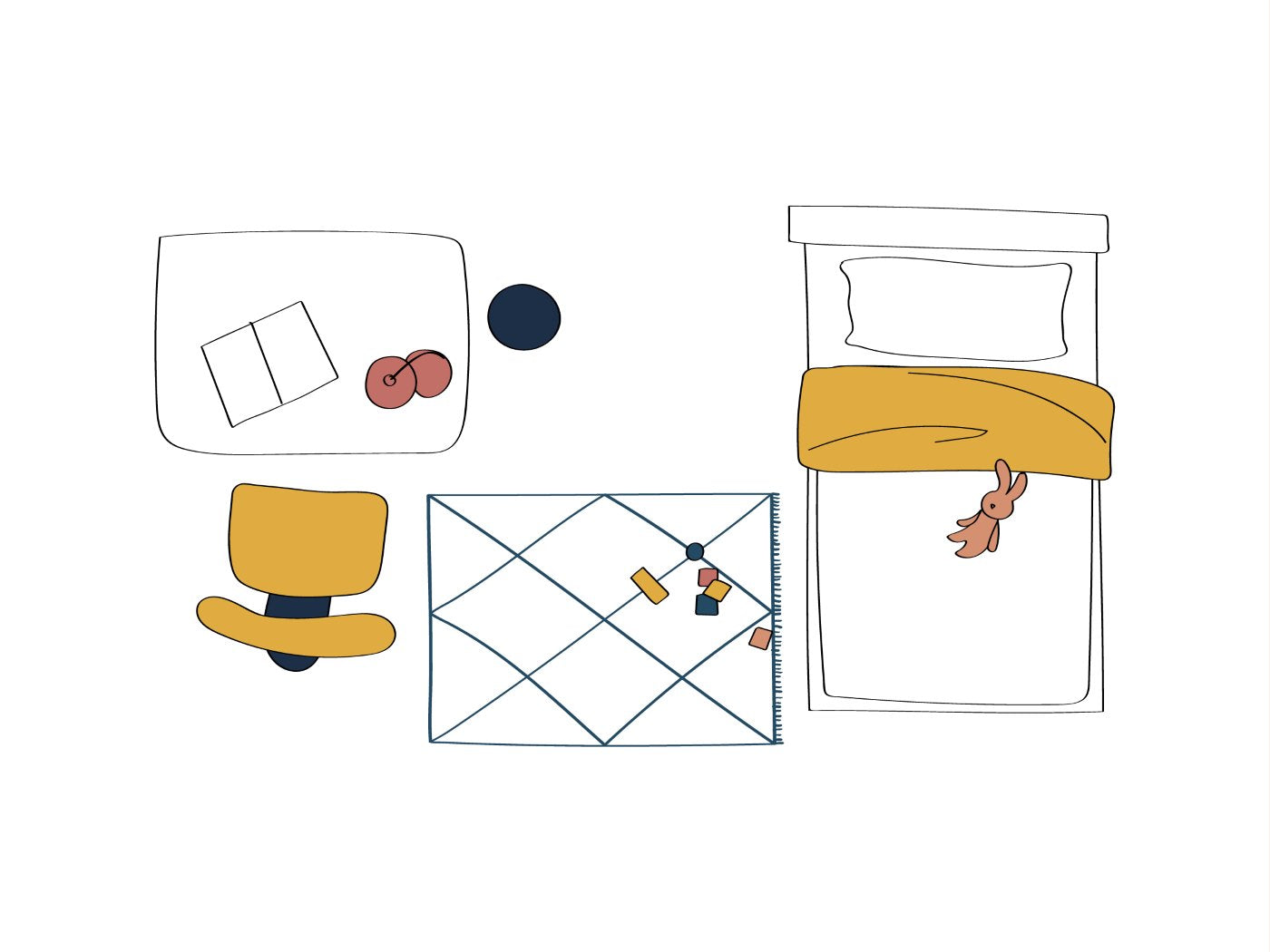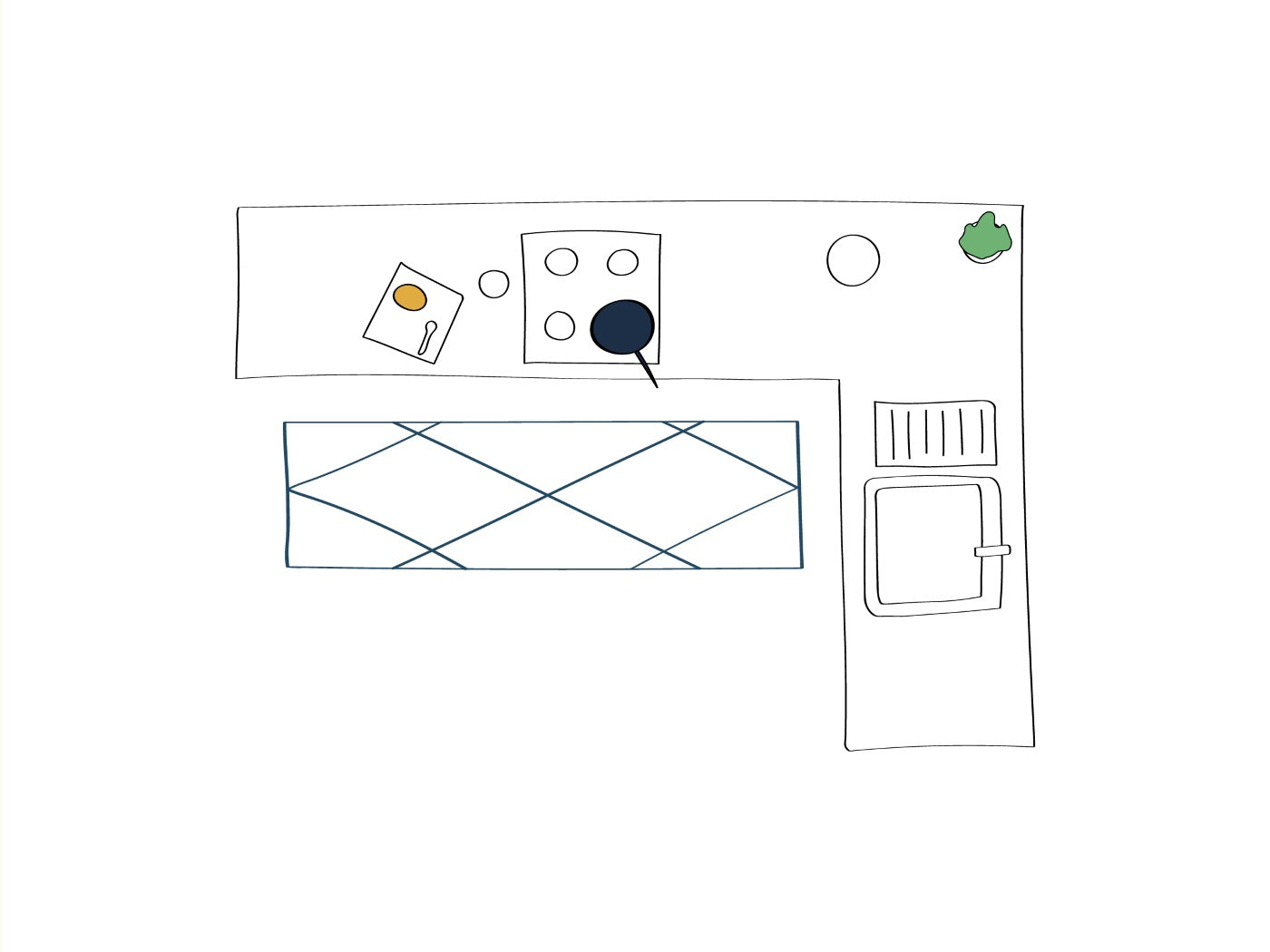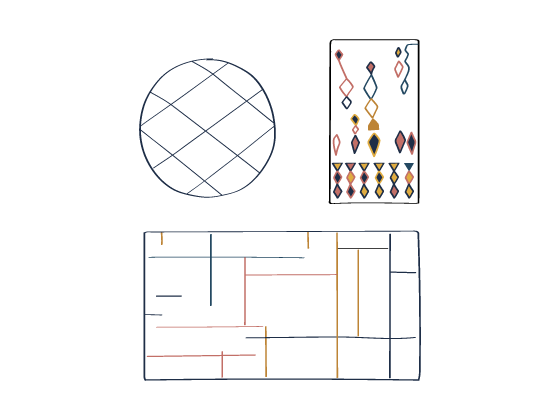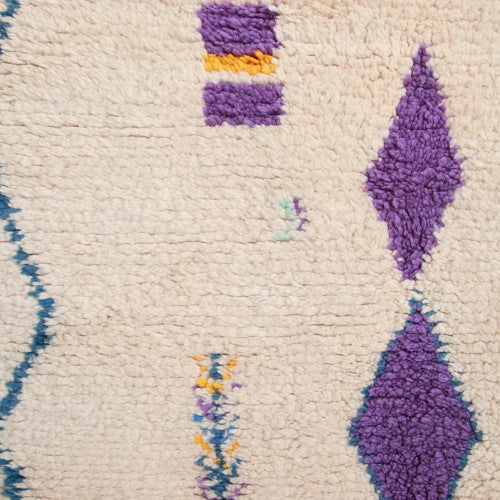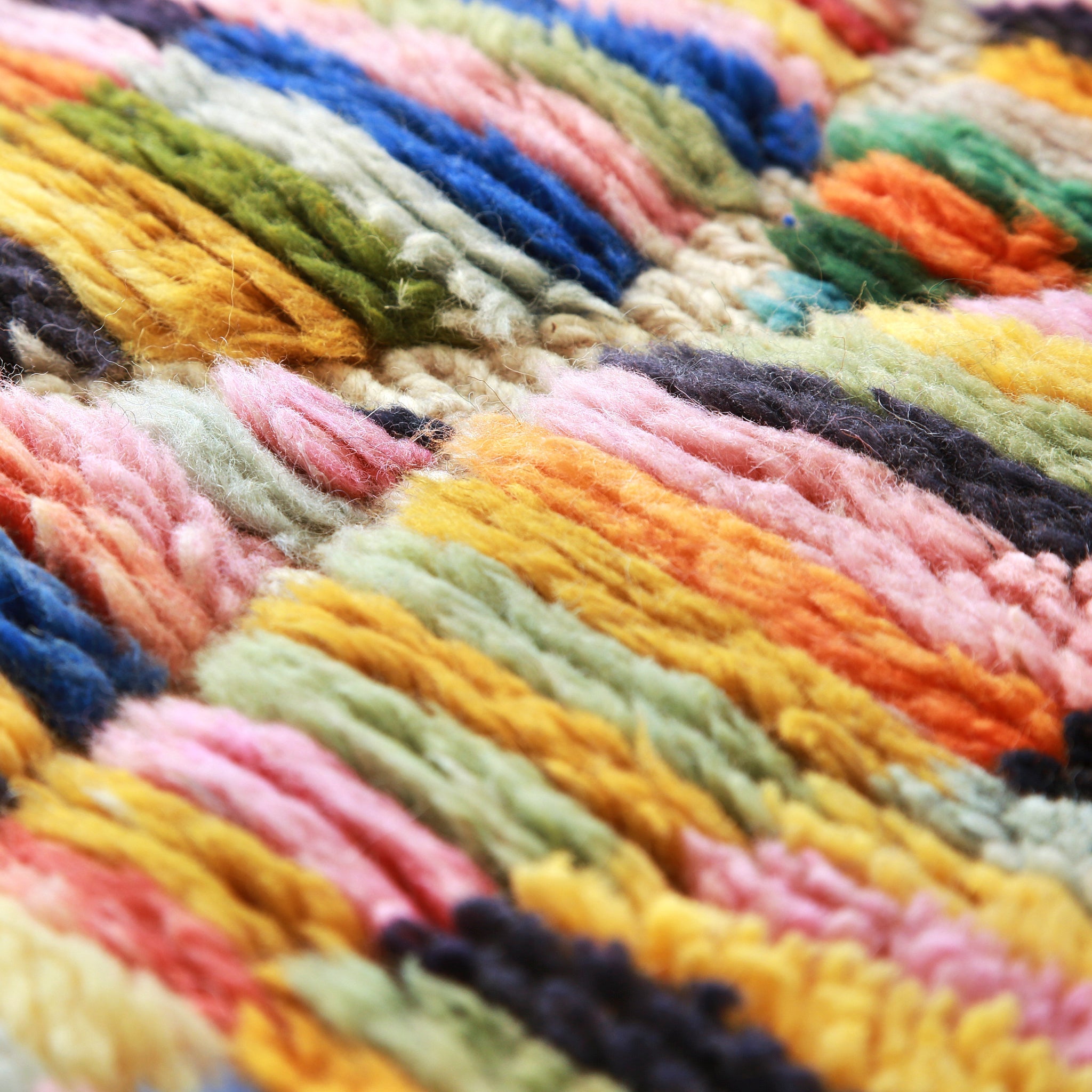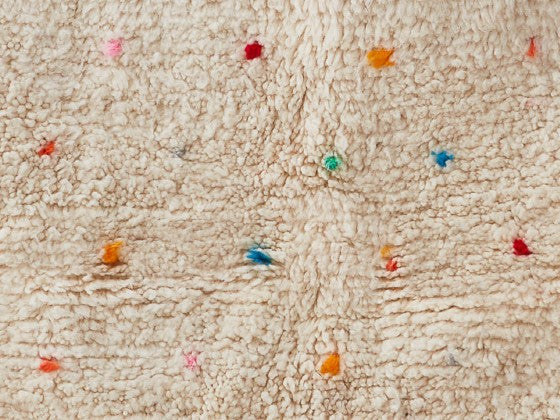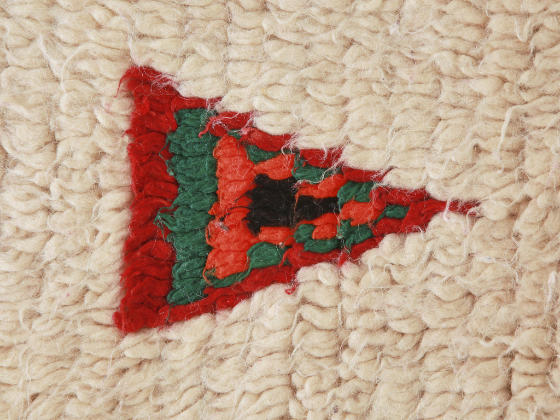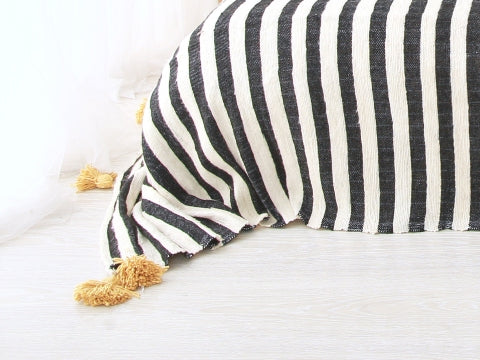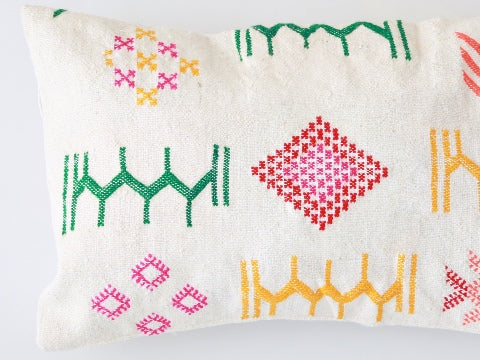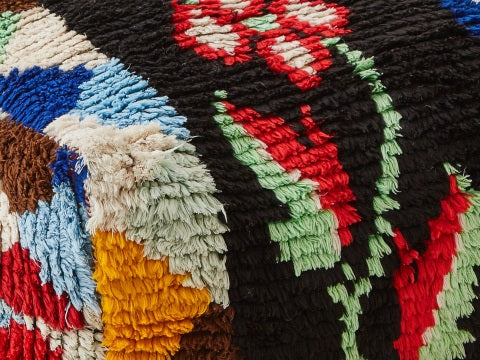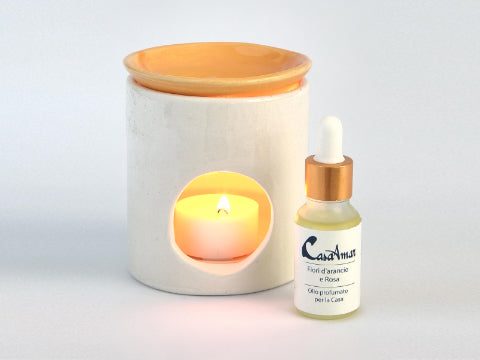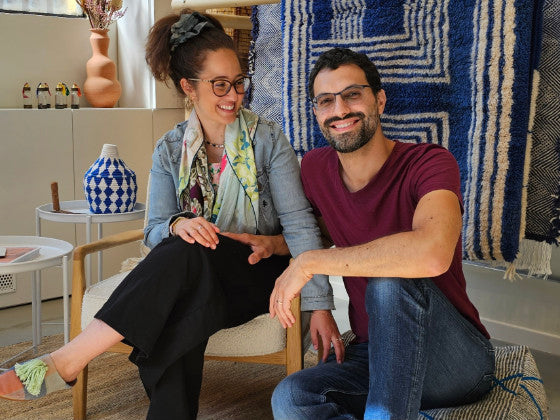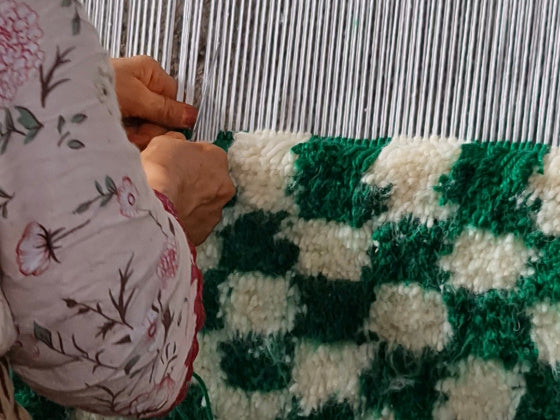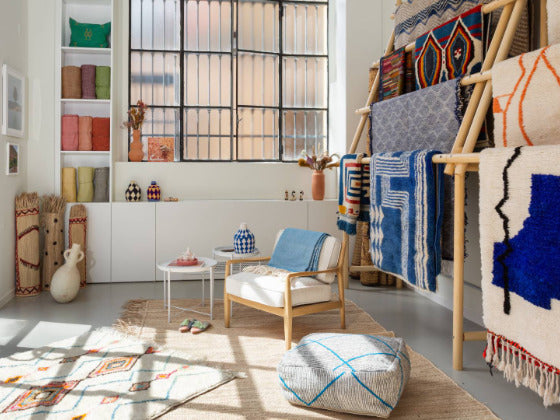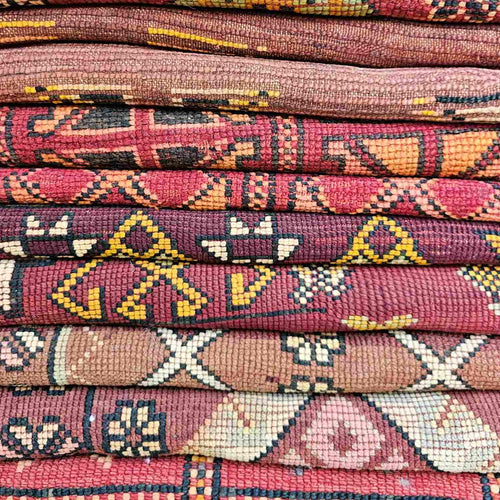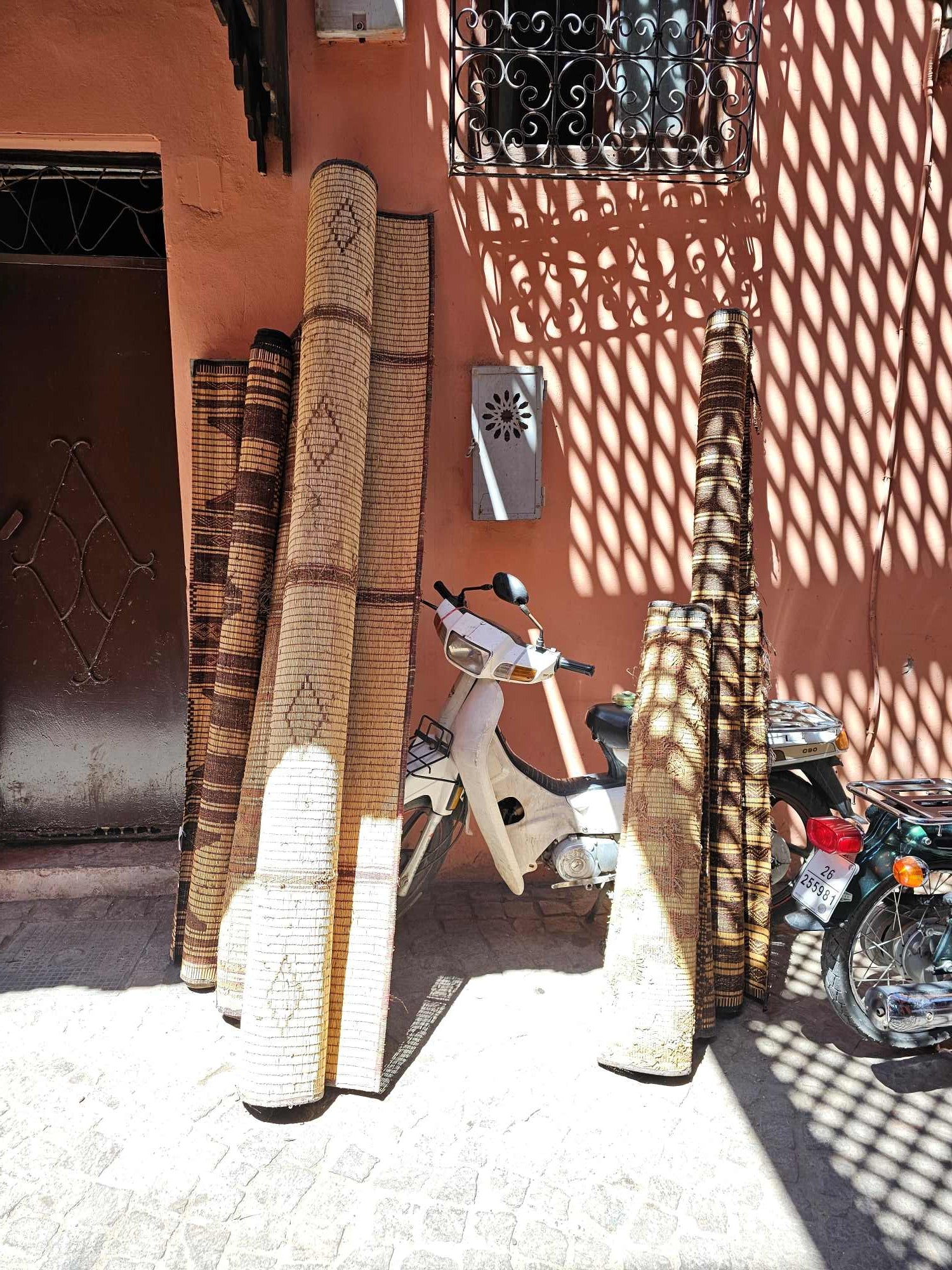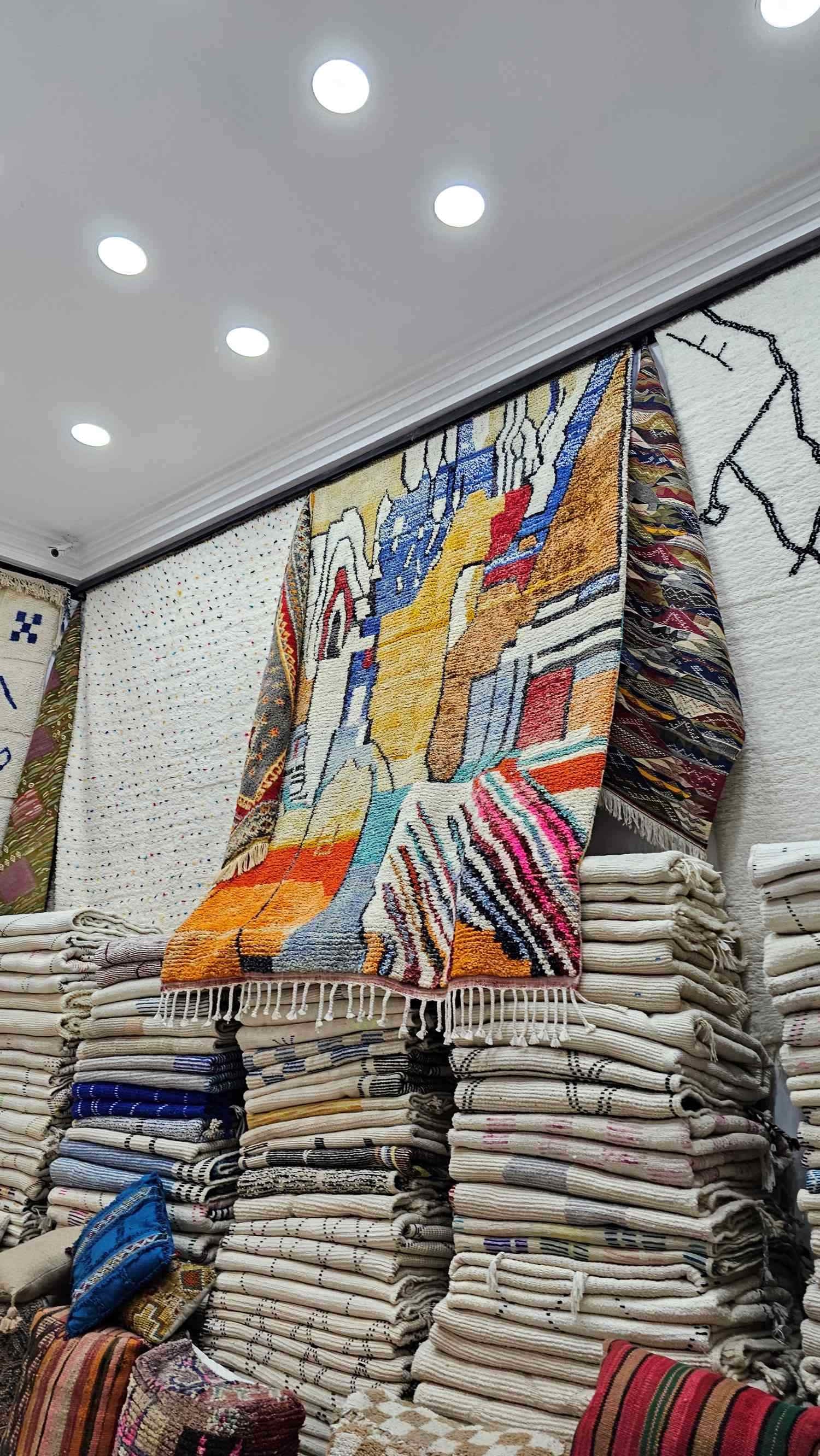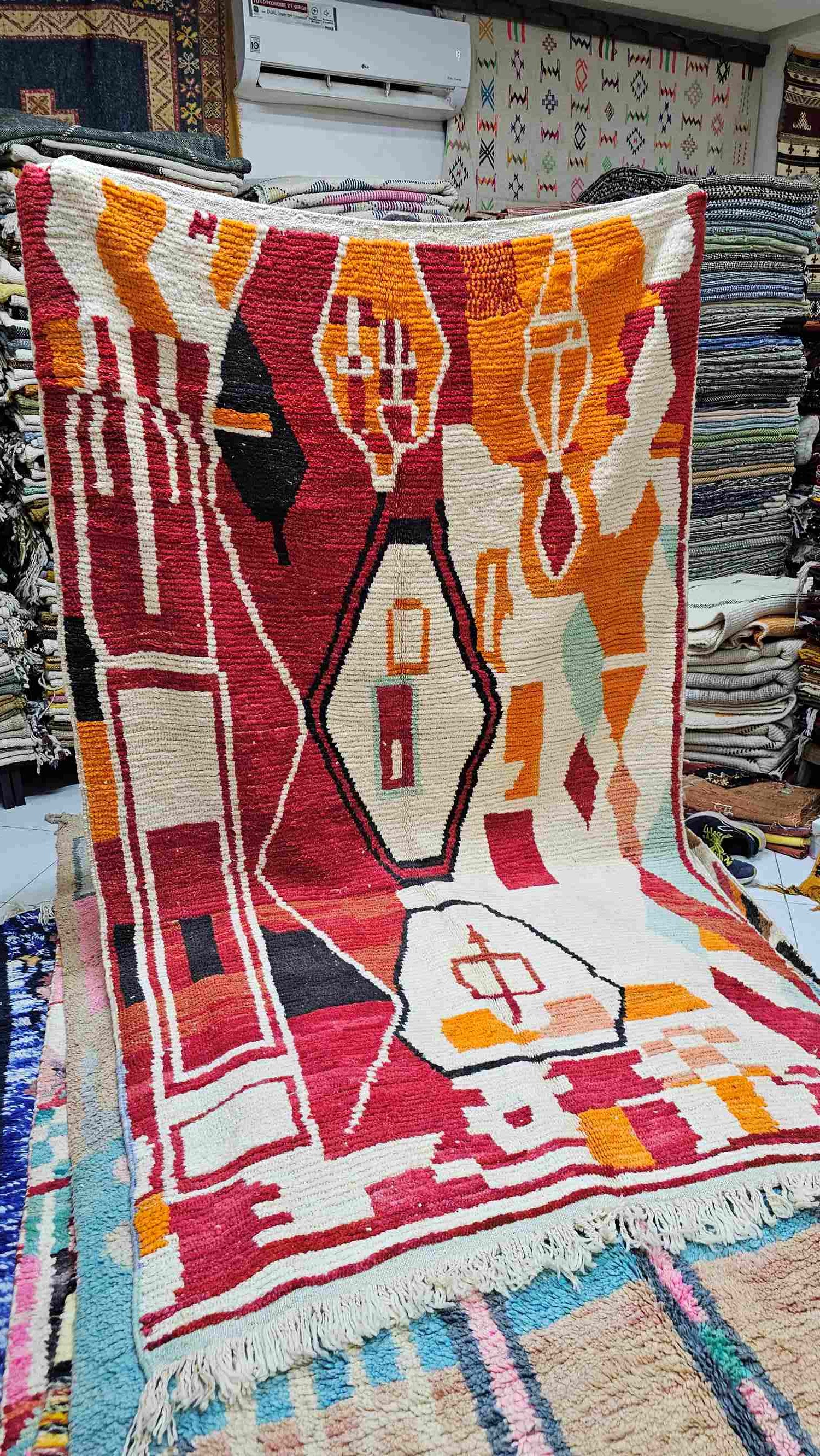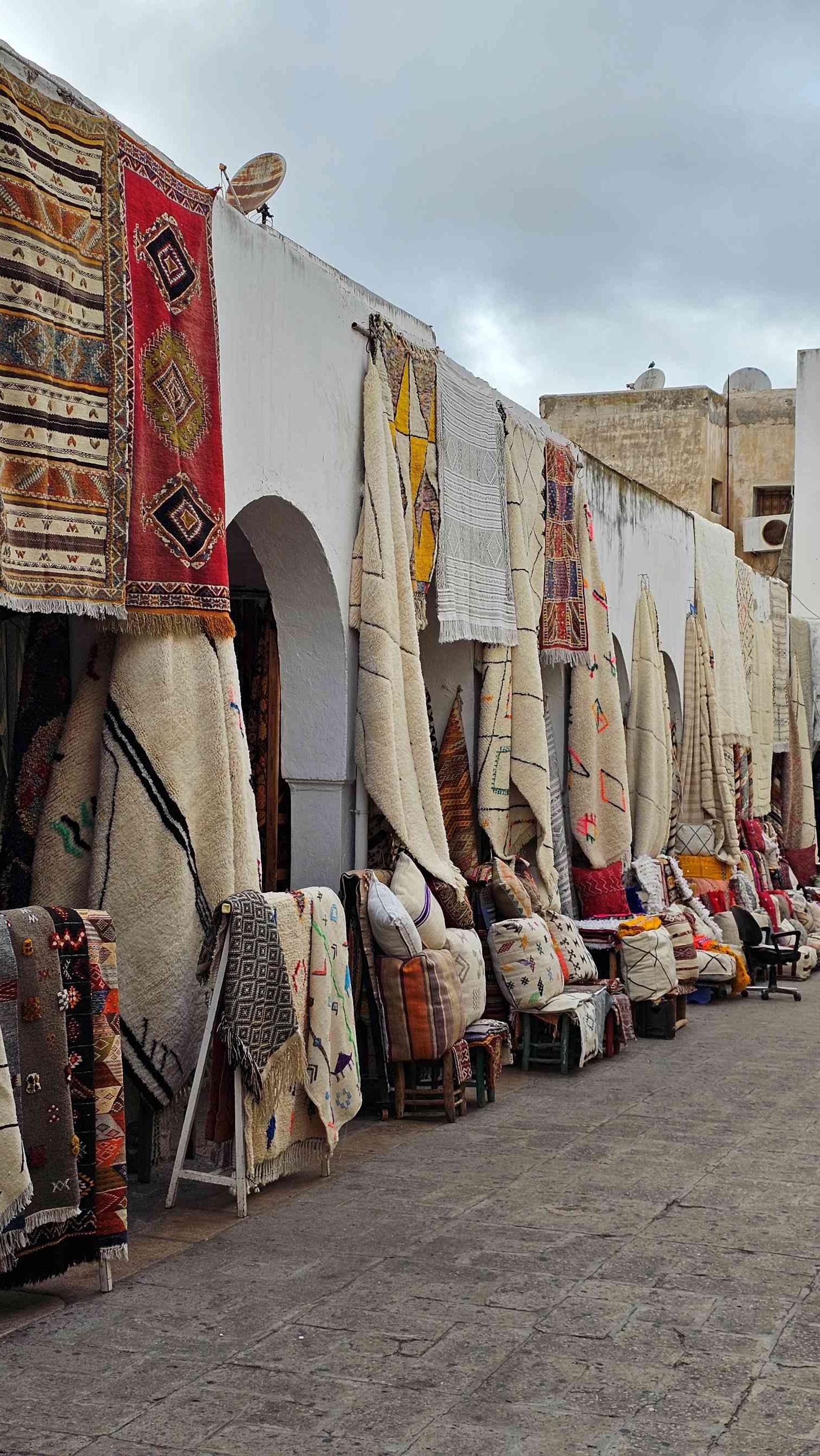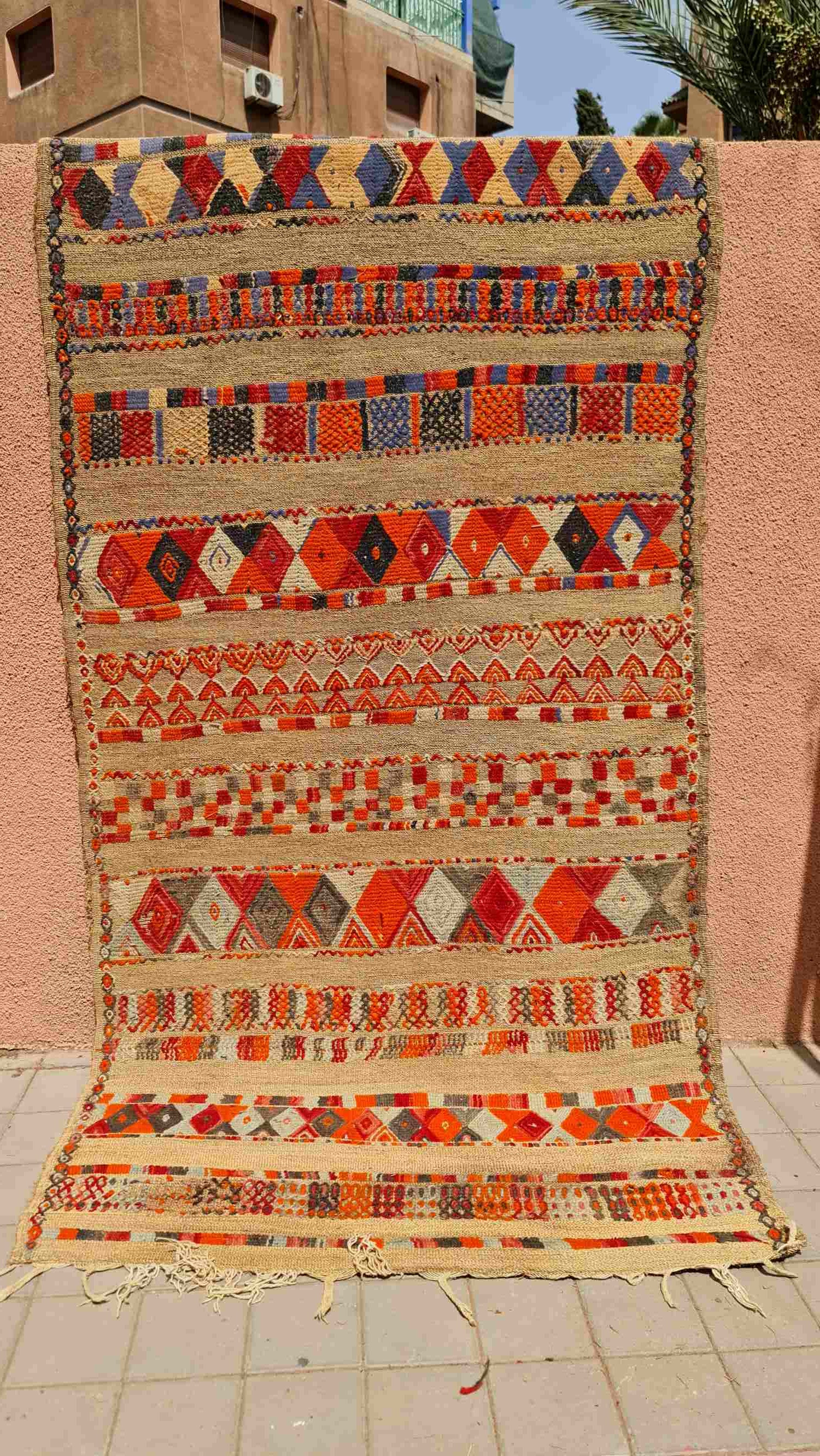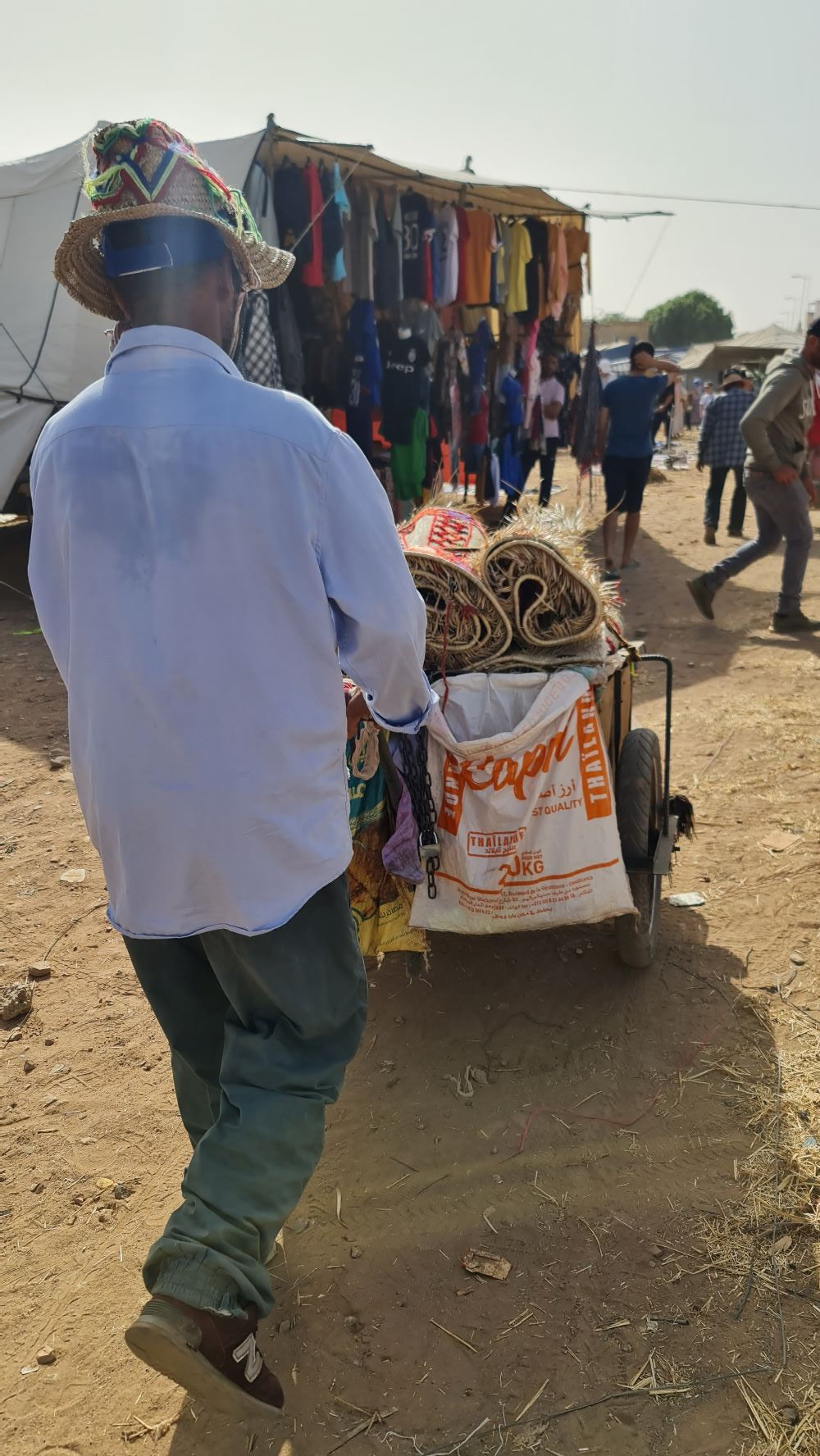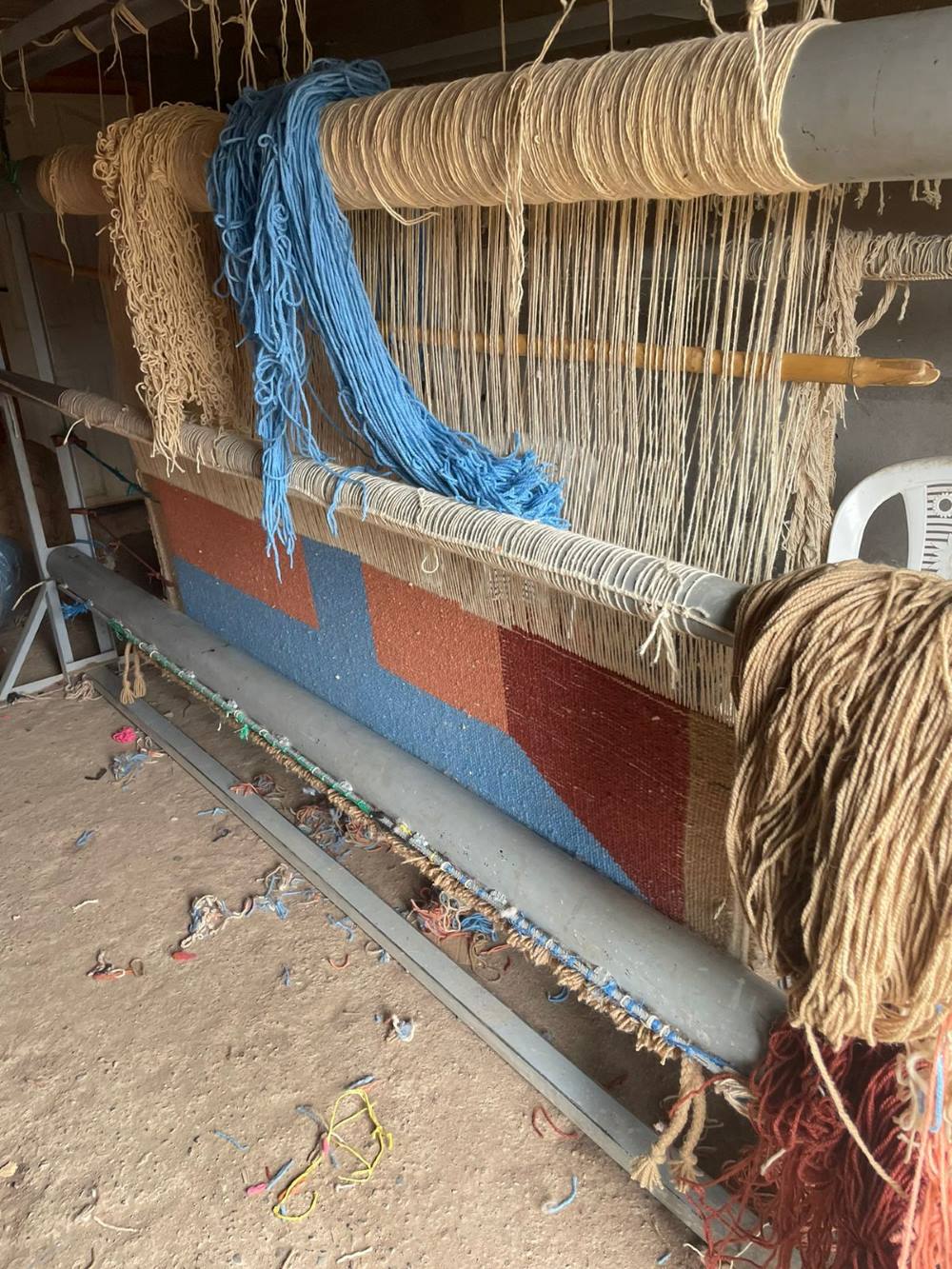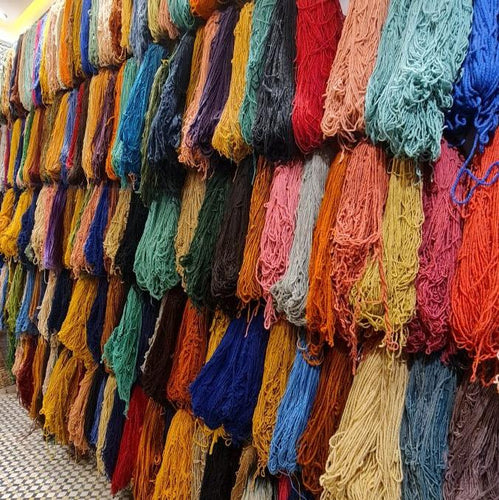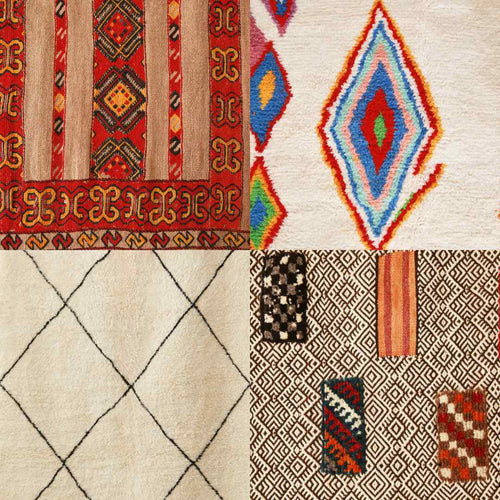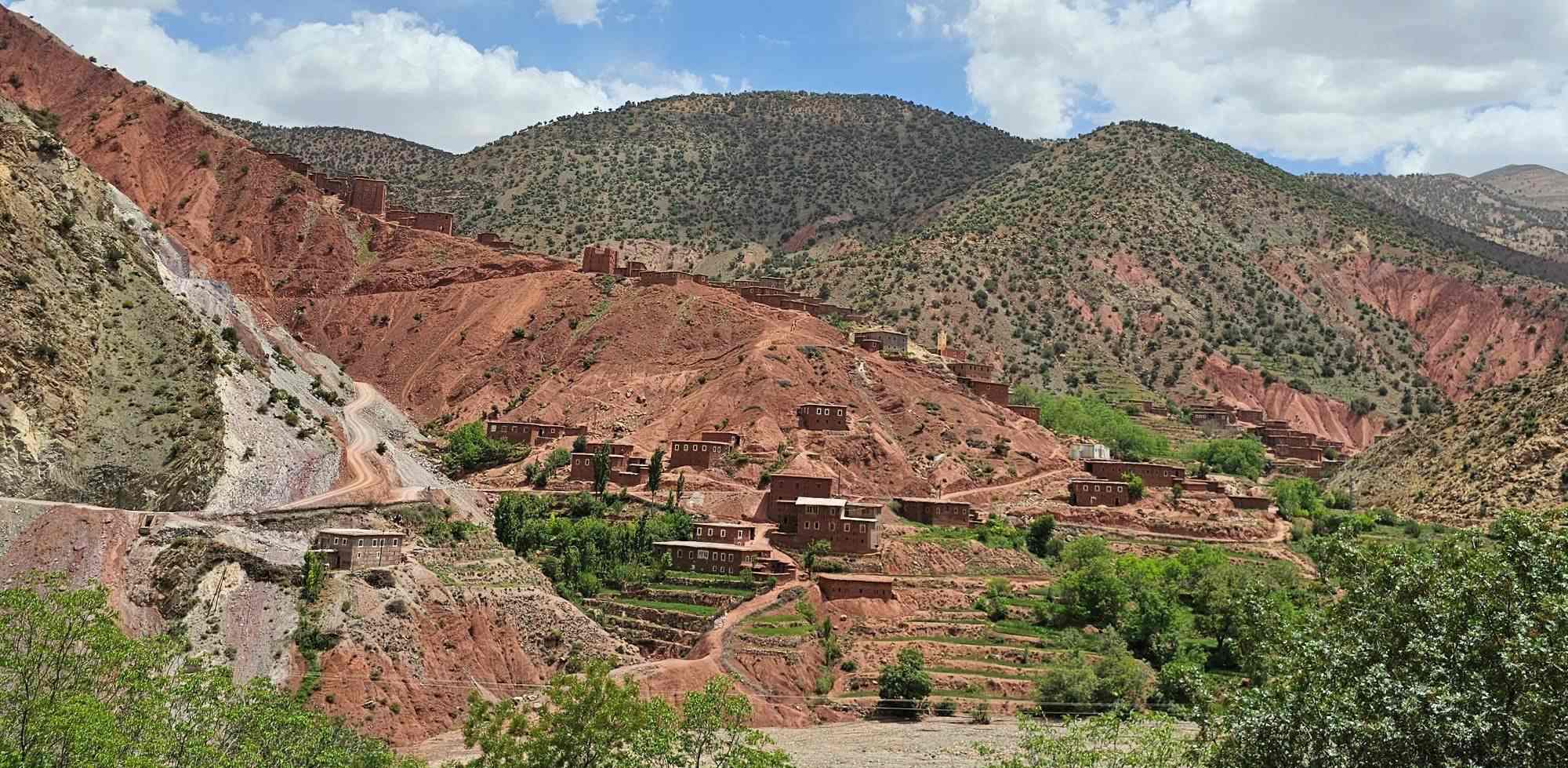Talking about Moroccan rugs and prices is not easy for us, sometimes it seems almost demeaning to reduce everything to economic issues when for us these artifacts have an inestimable value. Yet we realize that the time has come to do so, if only to convey how complex it is to evaluate the price of a Moroccan rug.
The first question that comes to the mind of anyone who wants to buy is certainly: how much should I pay for a Moroccan rug?
Followed by: who do I turn to, where do I go?
In this case, there are three options: purchasing directly in Morocco during a trip, going to a physical store in your city, or relying on online e-shops .
A fourth option is auctions, usually reserved for connoisseurs who want antique Berber rugs with a proven value guaranteed by the auction house. But we will see this little by little in the course of the article.
We do not claim to provide a complete guide, but we want - and can - try to reflect on what the REAL price of an original Moroccan rug is.
We will tell you how to recognize a handcrafted product, we will try to calculate an approximate price of a rug and we will also give you some suggestions on where to buy Moroccan rugs.
We will talk about:
- How to recognize and evaluate the quality and value of a handmade rug
- How much does it cost to produce a Moroccan rug?
- The truth behind low-cost rugs
- Where to buy Berber rugs ethically and responsibly
- Buying Berber rugs in Morocco: Prices, Bargaining and Other Legends
- Recap: where and how to buy, what is the right price
But first, since we have capitalized the word “real”, let’s briefly explain what we mean by an authentic Moroccan rug, and we do so with an extract taken from a previous article:
What defines a Moroccan rug is first of all its origin: it is not (only) a type of decoration or a workmanship or, again, a fabric. To define a rug as a Moroccan rug, the artifact must be made in Morocco. [...] Although it may seem like an obvious statement, in fact, it often happens to come across, even online, "Moroccan rugs" or rather, sold as such but which in reality are produced in Pakistan, India, Turkey ... Be careful because in these cases there are some risks. Often they are completely industrial or only partially artisanal rugs, which use Amazigh designs even if they have nothing to do with original Moroccan rugs. Furthermore, the production methods, the materials used and the treatment reserved for workers are very questionable.
Find out more in our guide to all types of rugs.
A note that we care a lot about: we will use the word Berber as a synonym to avoid repeating ourselves too much, but know that we don't like it at all . As we explained in the post just linked, Berber is in fact a word with a negative connotation that does not identify an original Moroccan rug: we could actually tell you that those who use this term like Moroccan or Amazigh do not know Morocco intimately. Let's do this: consider it one more clue to suspect those who are trying to sell something they don't know so thoroughly!
 |
|
The stand of an artisan displaying her handmade rugs at the Mrirt Souk |
How to recognize and evaluate the quality and value of a handmade rug
Moroccan, Berber and Amazigh rugs can be extremely valuable and fetch prices of works of art .
It is not for nothing that some examples of Boucherouite, Beni Ourain or Zindekh are sold at auction or preserved in galleries such as the Musée Yves Saint Laurent Marrakech (which has dedicated the Musée Pierre Bergé des Arts Berberes to the Amazigh and the Desert Design exhibition to contemporary Moroccan rugs), and museums such as the Musée Boucharouite in Marrakech.
It is therefore essential to know how to recognize the characteristics that indicate that the rug you are about to buy is authentic and of quality, to avoid future disappointments.
Recognizing a hand-made rug
Let's start with some tricks to recognize a handmade Moroccan rug, hand-made (woven or knotted) in Morocco :
- Materials: Traditional Moroccan rugs are made of pure wool, cotton or recycled fabrics/materials , but with the advent of industrial yarns, acrylic has also been introduced (they call it tricot wool), which allows for a reduction in production costs and the selling price.
A word of advice: sometimes you will find it written (or you will be told) that the rugs are dyed with plants. The vast majority of Moroccan rugs are not made with naturally dyed wool, and you can usually tell right away from the colors. In these cases, ask what dyeing herbs were used to see if they lied or not! - Also be wary of anyone who talks about cactus silk without explaining what it is: it is now a purely commercial definition and has no basis, since it is almost always viscose.
- Techniques: Authentic rugs are handmade, not machine-made . They can be knotted or woven with the help of a traditional loom. The knots are tightly packed and well-made to ensure strength and durability. The edges are finished to prevent fraying.
- Softness: this is one of the main characteristics , and is due to the special wool of the sheep raised in the Atlas area and to the mastery of the manufacturing techniques, sometimes secret as in the case of the Beni Mrirt.
- The origin: always check the production area of the rug (trivial as a suggestion? as we have seen, not at all).
- The value of unique pieces: handmade rugs, being such, have small imperfections and irregularities that demonstrate their authenticity. They will never have a perfect shape, or symmetrical dimensions measurable to the millimeter; not being machine-made, they respect some dimensional standards that depend on the size of the loom and - in part - on the needs of the market; and they will never have particular or strange shapes that do not respect tradition.
- Visual analysis: look carefully at the weaving technique and the consistency of the knots , and note whether there is a hard edge (handmade rugs do not have a hard edge) or glue (absent in hand-made rugs)
- Fire test: online you will find a suggested test that suggests burning a thread of the rug to see if it catches fire and thus establish whether it is made of pure wool or synthetic material. According to this theory, animal fiber should not catch fire, but in reality even wool can burn, only that the reaction will be slower and weaker, the flame will be less lively and slower and the result of the carbonization will be limited and dusty. It does not drip, does not melt, has no chemical odors, does not explode, does not spread and self-extinguishes - we do not support this test but we thought we would report it for completeness.
...and the price? Authentic Moroccan rugs cannot be low cost . Be wary of the cheapest rugs and make your own considerations, also using this little guide of ours!
One last tip to be sure to buy an original Moroccan rug is to turn exclusively to specialized retailers or e-shops . They will certainly have specific training and useful skills to guide you to the right purchase.
Evaluating the price of a handmade rug
Beyond the criteria to understand if a Moroccan rug is authentic or not, we would like to reflect together on some points. Follow us in the following reflections:
- Material and manual work
High quality Berber and Moroccan rugs are made, as mentioned, from pure wool or other natural fibres. The sourcing and finishing of this precious raw material requires time (care of the animal, shearing, washing, carding, spinning, washing and treatments of the finished product), effort, craftsmanship, knowledge and weaving skills passed down through generations. All of this - the type of material used, its quality and the nature of the manufacturing - inevitably affects the price . You can save by buying a Moroccan rug in acrylic or a Boucherouite (generally cheaper due to the materials used) or a second-hand Moroccan rug (often cheaper than new). - Cultural heritage
To the above-mentioned factors are added the creativity of the craftswomen and the skills acquired over the years, an invaluable intangible heritage , from which designs, symbols and details are born that make each rug unique in the world. Each of them, weaving, silently tells the story of a life, the salient moments of her existence and of the women of her people, the traditions of the place where she lives, her aspirations and her little secrets. - Size and complexity of the work
The price of a rug is influenced, as you can imagine, by the size and complexity of its design : larger rugs will have higher prices due to the amount of material used and the time needed to make them; intricate patterns and designs, changes in color or yarn, the presence of fringes… require meticulous manual work and are therefore more expensive than plain-colored or simple-designed rugs. Even the final wash can contribute to increasing the cost: think of the Beni Mrirt and the highly secret washing techniques that make the wool particularly silky and shiny. - Conditions (for vintage, used, antique rugs)
In the case of pre-loved, second-hand, or luxury and antique rugs, age and condition significantly affect the price. If the rug has historical value but is still in excellent condition and is rare (such as some Saharan and Tuareg rugs ), it will clearly be more expensive.
Have you ever thought about how many things there are to consider before talking about the price of a Moroccan rug? To explain better, we will tell you how much the work of an artisan costs and what other costs must be considered to arrive at the final price.
 |
| Dyed wool during drying |
How much does it cost to produce a Moroccan rug?
To fully understand the value of a handcrafted Moroccan rug we need to know all the costs of the workmanship. We could divide them in this way:
- Cost of raw material
Most Moroccan rugs are made from sheep's wool . The wool is cut, washed, carded and spun. The artisans can do these operations by hand, especially if they have sheep, as well as buying wool at the market. In this case, the cost of transport can be added to the cost of the raw material, since in rural areas, major purchases are generally made at large weekly markets.
The cost of wool varies according to the quality : from 2 euros per kg to 8 euros per kg. For example, a 2 x 3 m Beni Mrirt rug requires up to 30 kg of high quality virgin wool to make it (the final rug will be lighter after the finishing stages).
The cost of wool also depends on its color : wool can be purchased colored or dyed by hand with commercial pigments or, in rarer cases since it requires great know-how and several days of work, it is dyed with dyeing herbs. - The cost of labor of artisans
This is one of the most complex variables to calculate, because the cost of a craftswoman depends on the type of work she does, how it is calculated and the region she comes from , in fact the cost of living is very variable.
Keep in mind that there is not even an official hourly rate because often the craftswomen are not used to quantifying the hours of work.
In Morocco there is a minimum wage (which varies between rural and urban areas) but the state cannot carry out checks so it is not certain that it is respected.
There are also differences depending on who supplies the wool (whether it is provided by the artisan herself or whether it is procured for her).
Well, it's not easy at all. In our small way we try to collect as much information as possible. And we don't hide that one of our dreams is to create a real atelier with a training center for our artisan employees. - Hours of work required
In addition to preparing the wool, the working hours include preparing the loom and the warp, which requires the work of at least 3 craftswomen.
The hours of work to knot or weave the rug vary according to the style of the rug, the techniques used and the quality of the workmanship. To give you an idea, to make a 2 x 3 m Beni Mrirt rug, about 30 days of work are needed by 3 craftswomen gathered in front of the loom.
When it comes to a knotted rug, the working hours depend a lot on the quantity of knots made.
For example, rugs from the Taznakht area , known for their great finesse, can have up to 160,000 knots per square meter! - Profit of any intermediary
Many Moroccan and international retailers claim to sell "without intermediaries" but these are often statements that demonstrate insufficient knowledge of the country.
The work of the intermediary can be useful and valuable, since many of the artisans make their rugs from home and do not necessarily have the means to sell their works. In these cases, the intermediary goes door to door in the villages and travels hundreds and hundreds of kilometers. The same happens for the collection of vintage rugs.
In these cases, the work of the intermediary must be valued and paid fairly , just as the work of the artisans must be paid fairly. - Transportation from the place of creation to the final destination : from the small village to the big city, and finally to your home.
Thinking in this way it is easier to realize how much an original Moroccan rug really costs. And how it is impossible to find low cost handcrafted rugs. They will probably be for the final buyer, but this means that someone (usually the weaker party) loses profit... and dignity.
 |
| A craftsman cuts the edge of a rug |
The truth behind low-cost rugs
The growing demand for artisanal products has - paradoxically - led to the spread of exploitation systems put in place to satisfy a global market that associates craftsmanship with a lower cost of the final product. This distorted belief is based on the false assumption that costs are reduced by the absence of advertising investments, expensive machinery and technologies, managerial professional figures... normally not involved in the creation and production of artisanal objects. Nothing could be more false and misleading!
We give you some food for thought to help you understand what lies behind the market for cheap Berber rugs passed off as handmade .
Rugs produced in Morocco at a low cost
In Morocco and other regions, artisans, both men and women, risk earning very little compared to the selling price of their rugs, and it is not easy to understand whether what we are buying has a fair price.
There are cooperatives that protect the work of artisans, but even in this case it is good to be careful: the real cooperatives are those in which women spontaneously collaborate with each other and share costs and profits. The most widespread, however, are cooperatives in which women are coordinated by a man (who generally has a little more knowledge of mathematics, English or what is needed for bargaining) and in that case it is not clear whether the artisans are paid equally.
So try to understand if by buying a low-cost rug you are damaging the manufacturer.
 |
| Entrance of a cooperative in Ait Bouguemez |
Fake Berber Rugs
As we said at the beginning of the post, Moroccan rugs, to be defined as such, must be produced in Morocco, mainly in the Atlas mountain areas.
Yet, to meet the demand for low-cost rugs, production has over time been relocated to other countries such as India, Pakistan, Turkey and China, where labor costs are lower.
To deceive potential buyers, these rugs are often called “Moroccan style rugs” or “Berber style rugs”.
Therefore, be careful to verify the real origin of the artifact.
Risks of low-cost rugs
“Ok, I would still like to buy a low-cost Moroccan rug, what difference does it make?”
Purchasing choices are personal and not judgeable but it is always good to consider every consequence. Let's see what it can mean to buy a product passed off as artisanal and original:
- Lower quality: Let's start with the quality, which will obviously be different, because to keep costs down, synthetic or low-quality materials are often used instead of wool, reducing the quality and durability of the rug.
- Underpaid labor: Often the labor employed in those countries for the manufacturing is underpaid , which is one of the main reasons for the attractive price.
- Exploitation: Low-cost rug factories can operate in exploitative conditions , with long shifts and wages that do not meet international labor standards.
- Child labor: In low-cost markets, the risk of young boys and girls being employed in production is high . Countries such as India, Egypt and Pakistan are known to have child labor problems in the textile industry.
To minimize these risks, it is important to buy ethically. How do you do it? In this post, we will give you some tips.
Where to buy Berber rugs ethically and responsibly
Here we are. You have decided to buy an original Berber rug and you are trying to understand how, where.
Directly on site? Online?
How to navigate the offers? How to evaluate a seller, or an e-shop to avoid bad shopping experiences?
Let's try considering the different hypotheses.
Buying Berber Carpets in Morocco: Prices, Bargaining and Other Legends
You go to Morocco and want to take advantage of the trip to buy a handcrafted product by choosing it directly from a cooperative or in a souk. Where to go? How to do it? Who to trust?
We all know the satisfaction of returning from a trip with a valuable handcrafted object. The sweet melancholy that invades us looking at it and thinking back to the good times lived, the experiences, the scents, the colors of a foreign land.
It is usually purchased in artisans' workshops or on market stalls. Unfortunately, however, there is an attitude towards certain countries that can even become disrespectful: negotiation at all costs, bargaining down.
We asked ourselves if anyone has ever negotiated the price of a product in a market in Sweden and we are - almost - certain that the answer is NO! This instead happens in African markets and more generally in Islamic and Asian countries.
And if it is true that bargaining is a highly appreciated art - from which, however, there should be a return for both parties - when we happen to read phrases such as "immediately offer half the price requested by the seller and negotiate" or "the tourist is seen as a walking ATM" , we perceive between the lines a belittling attitude. In Morocco, bargaining is, yes, systematic but not aggressive; it is not considered offensive but we advise you to concentrate on the product before asking its price : show interest in the materials, the origin, the workmanship... it will be greatly appreciated. Rather than asking for an excessive reduction, find out if there is a less expensive alternative, the seller will be able to help you.
The Market: The Souk of Marrakech
In the medina, the beating heart and historic center of the oldest cities, there are traditionally located bazaars and souks (or suq, suk), that is, shops and markets that attract millions of tourists every year, attracted by the richness of Moroccan craftsmanship. We are not just talking about rugs, but also objects and accessories in leather and copper, jewelry, nomadic art, spices, oils and beauty ointments such as argan.
Some medinas of Morocco, specifically Fez, Marrakech, Tetouan and Essaouira are UNESCO heritage sites. Marrakech became one in 1985 and for decades now its souk, located in the northern part of the Jamaa el Fna square, has become an obligatory destination for tourists in search of Berber rugs. Marrakech is the largest and best-stocked market but it is not the only one : there is also the Habous of Casablanca, the Medina of Rabat, the Medina of Tangier, the Medina of Fez, the Medina of Essaouira or the Medina of Ouarzazate.
 |
| Rugs exhibited at the Habous in Casablanca |
 |
| The Medina of Essaouira |
Cooperatives and solidarity markets
- Cooperatives
As we said above, you can contact the cooperatives, being very careful to identify a real one to avoid damaging the artisans. Ask if the one you are buying from is made up of women who have spontaneously joined forces to share costs and profits, or if behind it there are other people who keep part of the proceeds. - Solidarity markets
In support of artisanal work, the state also provides spaces with reduced or no rent where women can display and sell their rugs(like this one in Casablanca). Other good references that we could give you are the Ensemble Artisanal de Marrakech and the Centre de promotion féminine des tapis de Taznakht.
We buy rugs guided by our encounters and our experiences . We really like going to the regional “souks”, huge popular markets, always crowded, where you can find everything, from dried fruit to household appliances.
These are also a unique opportunity for us to meet artisans who work from home and come to the market to sell some rugs before going shopping. But to be sure to meet them, you have to arrive very early, even at dawn! In the markets we also find small traders who collect rugs made in their community and these encounters represent opportunities for us to exchange and constant learning.
 |
 |
 |
 |
|
Trips to discover markets and handcrafted Moroccan rugs for our e-shop
|
Buy Moroccan Rugs Responsibly Online and Offline
For a novice it is not easy to understand where and how to buy an original Moroccan rug online, but by reading this guide you should have a clearer idea.
When evaluating a Moroccan rug e-shop, first pay attention to:
- Shop specialization: does it sell all types of rugs? Does it only focus on Berber ones? Surely in the second case they will be better prepared.
- Specific skills of the seller : useful for understanding whether there can be good assistance for the purchase and post-sales support for the management and maintenance of the product
- Origin of products (area, tribe, name of the rug): is it indicated for each artifact? Is there information on the original area?
- Quality (of wool, of elaboration) : Are there information regarding production, materials used or weaving techniques?
- Final price : is it low, medium, high? Does it seem appropriate given the product description?
- Discount policy : be wary if you see exaggerated discounts (don't they sound unbelievable to you?) or if you notice that the site constantly advertises discounts pretending that they will expire soon (and then repeats them punctually)
Online sales from retailers committed to ethical sourcing
Browsing online you can find several e-shops that sell Berber rugs, although not all of them are specialized. Some are generalist e-commerce sites that also have Moroccan rugs, others sell low-cost “handcrafted” rugs(can you hear how the two things clash together now?). In some cases it is quite easy to understand that they are not original rugs(we have seen this more on how to do it), in others it is a bit more cumbersome to orient yourself, especially if the portals have done a good job of graphics and marketing. We hope that after reading this post you will be able to understand whether what you are landing on is an e-shop that buys and sells Moroccan rugs ethically or not.
Our e-shop , for example, is one of the sites you can rely on for this type of purchase. We are Jihane and Matteo - husband and wife, she was born and raised in Morocco, he is Italian - and we have decided to dedicate ourselves to the sale of handcrafted Moroccan rugs respecting their value and the uniqueness of the products. We deal directly with artisans and craftsmen whom we visit personally to ensure the quality of the rugs and the ethics of the entire supply chain.
Our mission is born from a deep passion for the land of Jihane and its ancient culture. If you want to know us better you can read: Our History and the Values we believe in, or come and visit us in the showroom in Milan .
Moroccan Rug Shops in Italy
If you are lucky, in your city you may have some Moroccan rug shops, but it is not so common to find them in Italy (indeed), except in some areas or larger cities, such as Milan for example. Persian rug shops are much more widespread. In any case, if you find one, be careful and check that everything we have explained is respected. Make sure they offer you expertise, knowledge, authentic handcrafted rugs and also valid after-sales support , because these artifacts will stay with you for life.
If you don't find any store...we also offer our consultancy remotely!
Online and offline auctions
An alternative to consider for purchasing Moroccan rugs is to consult online auctions or participate in auction houses. As a purchasing method it is a little less immediate, but for people who are passionate about the genre it could be stimulating to be able to own an antique rug certified by experts.
Apparently it's simple: just google antique rug auction houses and search the internal search engines for Moroccan rugs. You might find some treasures!
What we advise against are auctions held by private individuals on various general marketplaces. If you intend to invest in an authentic piece, contact recognized and registered entities that will provide a certificate of authenticity and a verification by experts, condition reports, the possibility of inspecting the object before purchasing, clear and complete information on the provenance and estimated value. All criteria that allow buyers to make informed choices.
Recap: where and how to buy, what is the right price
We have reached the end of this long article. Let's recap together the salient points and the most important information to calmly face the purchase of a Berber, Moroccan or Amazigh rug:
How to evaluate
We have told you in an exhaustive way the important parameters to evaluate the authenticity of the rug, from the information on the origin and the materials to the aesthetic evaluations of the weaving techniques, from the credibility of the shop (offline or online) to its specialization. Of course, it is not so simple for those who are not in the sector, but we are almost certain that after reading this little guide at least you will not be sold a fuchsia rug passed off as a handcrafted Moroccan rug "dyed with plants" - perhaps in cactus silk -, nor a "Berber" carpet made in India.
Where to buy
We have seen what the solutions are for buying an authentic Moroccan rug, from purchasing directly in Morocco - in a souk or at a cooperative or a solidarity market - to purchasing from home, both offline and online: we have shown you the possible options for purchasing online (rug e-shops or online auctions) or offline (specialized physical stores). How do you choose the solution that best suits your case? Establish your priorities, based on your preferences regarding the need to touch with your own hands - for example - the need to have a direct dialogue with a person, the importance you give to after-sale service or the desire to browse a large catalog rather than a careful selection made by competent people.

